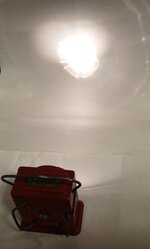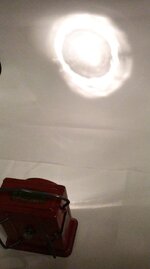Dr. Jones
Newly Enlightened
This is an old one, a "Buddy" flashlight lantern manufactured by the Delta Electric Company of Marion, Illinois in the early 1920s. Illumination is provided by an E10 base bulb with power supplied by 2 "D" cells, and is focusable.
This is a beautiful little light, and quite powerful for its time. The contemporary advertising for the lantern that I've seen claimed that it can project a beam 600 feet, and in truly dark conditions that may well be the case. As there is no longer any true night here in New Jersey due to light pollution, the farthest I've been able to reach on a moonless evening is around 400 feet, but in natural darkness as was the norm in the early part of the last century, along with the benefit of younger eyes, 600 feet doesn't seem out of the question. The reflector is well-designed and of very high reflectivity (it is first-surface silvered and uncoated), and the focusing mechanism concentrates the light wonderfully.
The focusing mechanism is quite ingenious, with a screw that moves the spring-loaded bulb carrier approximately one-half an inch back and forth. The beam is very tight at best focus, but does not diverge all that much at the other end of focus; it can hardly be deemed a floodlight in any sense (see the accompanying photos of both tight and open focus). Some later incarnations of this lantern dispensed with the focusing mechanism, perhaps as a cost-saving measure.
The bulb I'm currently using is a #245 of 11 lumens brightness with a current drain of slightly less than one-half ampere; standard carbon-zinc batteries can give steady illumination for up to 8 hours, more if the lantern is used intermittently. Modern alkaline batteries can of course quadruple that run-time.
There are two sets of handles present: a bail handle on top and two swing-out handles on the back of the lantern. The bail handle had at least two variations; that used on some later production is a bit taller and wider than that on the example here, perhaps to more easily accommodate a gloved hand. The swing-out handles on the back enable one to grasp the lantern firmly, although with only a three-finger grip due to their size; one can also thread one's belt through these handles to enable hands-free use.
The advertisements touted the on-off slide switch as being a heavy-duty "automotive" type, and it is indeed quite substantial. Notably, there is absolutely no point-to-point wiring in this lantern, as the entire circuit consists of brass or brass-to-silver contact points; needless to say, in order to get the best performance these contacts must be kept scrupulously clean, and the slide switch in my example benefitted greatly from a judicious shot of contact cleaner to its internals.
The circular glass lens resembles a shallow dome, and since the lantern came from the factory with the domed portion faced outwards, any sudden impact against the protruding glass, as from tipping over, could easily lead to breakage; thus I (and no doubt others) chose to reverse the glass so that it bows inwards. There is still sufficient clearance in this position to allow for full movement of the bulb as it travels when changing focus.
The reflector is silver-plated both front and back. The front has a high degree of polish, as would be expected, while the back is a bit duller and makes contact with a brass finger, with the silver plating providing an excellent low-resistance path to ground for the current. The silver naturally tarnishes over time, and since the reflector is not overcoated, contact with fingertips in the course of changing the bulb can add to its discoloration. As the silver consists of an extremely thin layer, great care must be taken if attempting to clean it. On this example I used a Kleenex tissue impregnated with a little Tarn-X, a silver cleaner that converts tarnish back into metallic silver and thus is non-stripping and non-abrasive, with excellent results, as can be seen in the accompanying photos. Very gentle wiping, with a water wash afterwards, brought it back to its former glory. Be forewarned that some reflectors may not respond to this treatment as well as this one did, so each case for such cleaning must be weighed individually.
As stated previously, the E10 screw-base bulb currently in use is a #245, producing 11 lumens and rated at 1.23 watts, roughly equivalent to the old Mazda No. 16. The lantern's paper insert also mentions using a Mazda No. 14 bulb, which is again roughly equivalent to a #233 bulb of 5 lumens and 0.7 watts. I found the #233 to be a bit dim for this lantern, but it would of course almost double the battery life over the #245, and would be fine for close indoor use. I've found that #245 bulbs, of good quality and reasonably priced, are available here:
https://www.grainger.com/product/LUMAPRO-Incandescent-Bulb-Incandescent-2FMT5
There were several variations of this lantern over the years, all of this pattern and color with slight changes, and my research indicates that this basic design was manufactured from 1919, the patent date, until sometime in the late 1940s, possibly the very early 1950s, with most of the postwar examples that I've seen being painted green instead of red.
Overall, a very well-designed, well-made, compact and useful lantern from the interwar period.

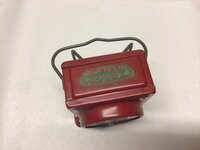
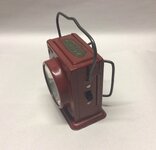
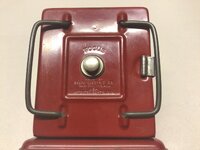

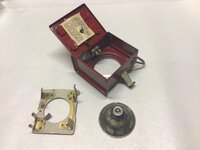


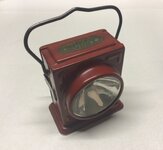
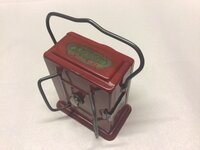
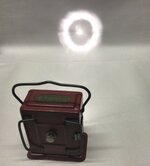
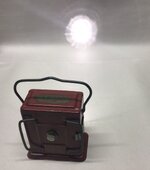
This is a beautiful little light, and quite powerful for its time. The contemporary advertising for the lantern that I've seen claimed that it can project a beam 600 feet, and in truly dark conditions that may well be the case. As there is no longer any true night here in New Jersey due to light pollution, the farthest I've been able to reach on a moonless evening is around 400 feet, but in natural darkness as was the norm in the early part of the last century, along with the benefit of younger eyes, 600 feet doesn't seem out of the question. The reflector is well-designed and of very high reflectivity (it is first-surface silvered and uncoated), and the focusing mechanism concentrates the light wonderfully.
The focusing mechanism is quite ingenious, with a screw that moves the spring-loaded bulb carrier approximately one-half an inch back and forth. The beam is very tight at best focus, but does not diverge all that much at the other end of focus; it can hardly be deemed a floodlight in any sense (see the accompanying photos of both tight and open focus). Some later incarnations of this lantern dispensed with the focusing mechanism, perhaps as a cost-saving measure.
The bulb I'm currently using is a #245 of 11 lumens brightness with a current drain of slightly less than one-half ampere; standard carbon-zinc batteries can give steady illumination for up to 8 hours, more if the lantern is used intermittently. Modern alkaline batteries can of course quadruple that run-time.
There are two sets of handles present: a bail handle on top and two swing-out handles on the back of the lantern. The bail handle had at least two variations; that used on some later production is a bit taller and wider than that on the example here, perhaps to more easily accommodate a gloved hand. The swing-out handles on the back enable one to grasp the lantern firmly, although with only a three-finger grip due to their size; one can also thread one's belt through these handles to enable hands-free use.
The advertisements touted the on-off slide switch as being a heavy-duty "automotive" type, and it is indeed quite substantial. Notably, there is absolutely no point-to-point wiring in this lantern, as the entire circuit consists of brass or brass-to-silver contact points; needless to say, in order to get the best performance these contacts must be kept scrupulously clean, and the slide switch in my example benefitted greatly from a judicious shot of contact cleaner to its internals.
The circular glass lens resembles a shallow dome, and since the lantern came from the factory with the domed portion faced outwards, any sudden impact against the protruding glass, as from tipping over, could easily lead to breakage; thus I (and no doubt others) chose to reverse the glass so that it bows inwards. There is still sufficient clearance in this position to allow for full movement of the bulb as it travels when changing focus.
The reflector is silver-plated both front and back. The front has a high degree of polish, as would be expected, while the back is a bit duller and makes contact with a brass finger, with the silver plating providing an excellent low-resistance path to ground for the current. The silver naturally tarnishes over time, and since the reflector is not overcoated, contact with fingertips in the course of changing the bulb can add to its discoloration. As the silver consists of an extremely thin layer, great care must be taken if attempting to clean it. On this example I used a Kleenex tissue impregnated with a little Tarn-X, a silver cleaner that converts tarnish back into metallic silver and thus is non-stripping and non-abrasive, with excellent results, as can be seen in the accompanying photos. Very gentle wiping, with a water wash afterwards, brought it back to its former glory. Be forewarned that some reflectors may not respond to this treatment as well as this one did, so each case for such cleaning must be weighed individually.
As stated previously, the E10 screw-base bulb currently in use is a #245, producing 11 lumens and rated at 1.23 watts, roughly equivalent to the old Mazda No. 16. The lantern's paper insert also mentions using a Mazda No. 14 bulb, which is again roughly equivalent to a #233 bulb of 5 lumens and 0.7 watts. I found the #233 to be a bit dim for this lantern, but it would of course almost double the battery life over the #245, and would be fine for close indoor use. I've found that #245 bulbs, of good quality and reasonably priced, are available here:
https://www.grainger.com/product/LUMAPRO-Incandescent-Bulb-Incandescent-2FMT5
There were several variations of this lantern over the years, all of this pattern and color with slight changes, and my research indicates that this basic design was manufactured from 1919, the patent date, until sometime in the late 1940s, possibly the very early 1950s, with most of the postwar examples that I've seen being painted green instead of red.
Overall, a very well-designed, well-made, compact and useful lantern from the interwar period.












Last edited:



